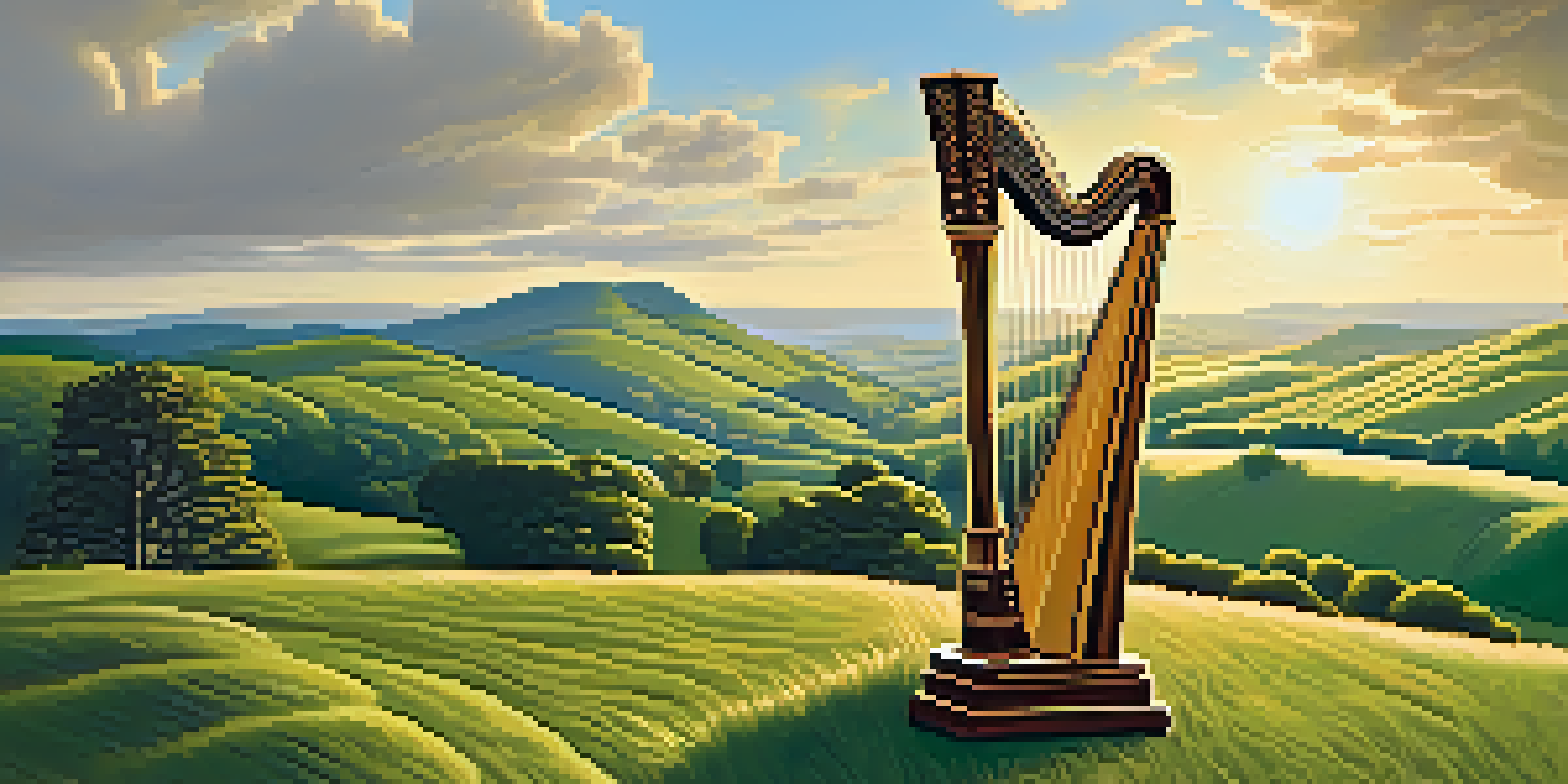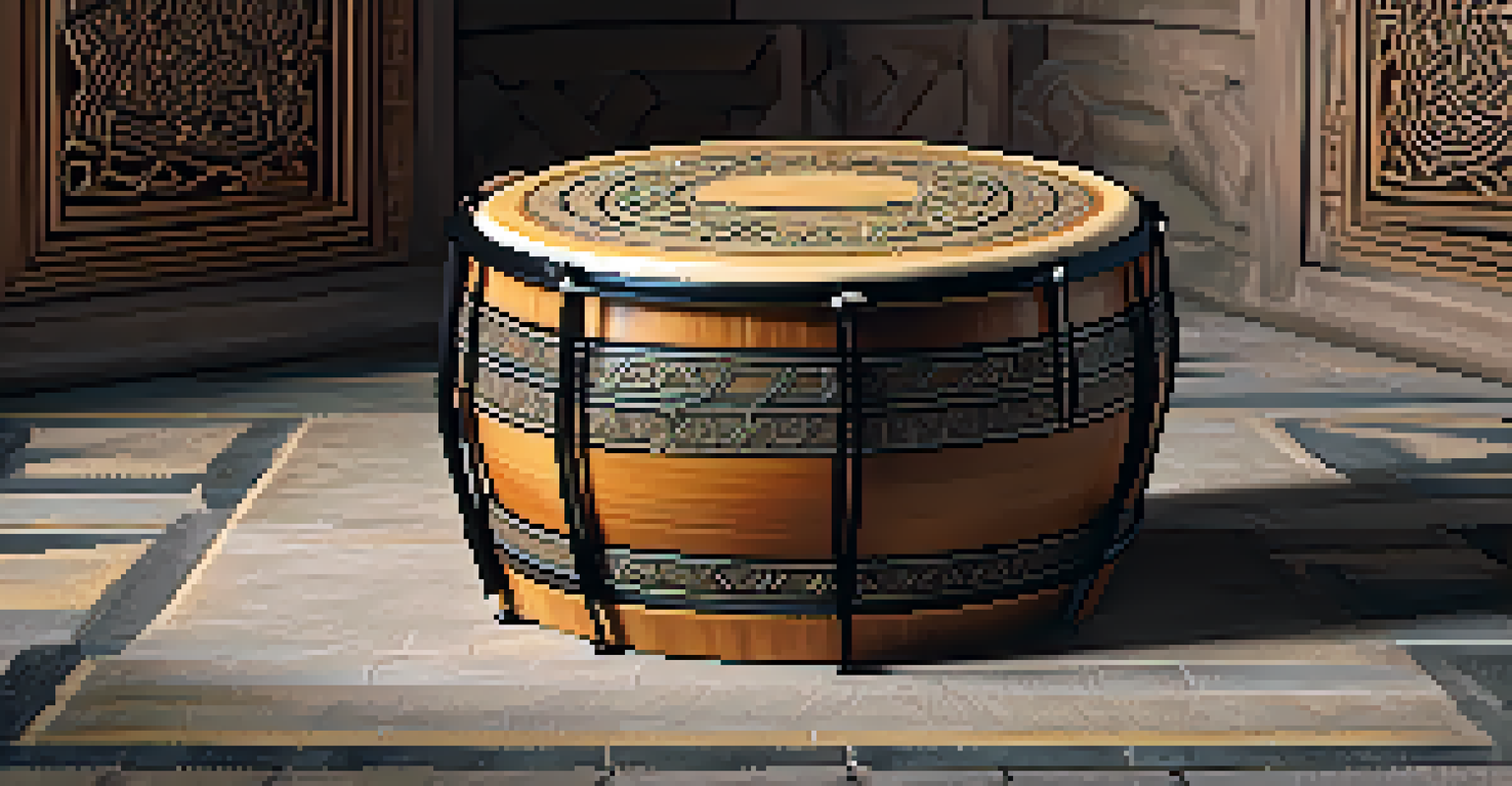Celtic Influences in Modern Music: A Cross-Genre Exploration

Understanding Celtic Music's Roots and Characteristics
Celtic music, with its rich history and heritage, originates from the ancient Celtic tribes of Europe. Characterized by its use of unique instruments like the fiddle, harp, and bodhrán, this genre is often associated with lively rhythms and haunting melodies. The oral tradition of storytelling plays a significant role in Celtic music, intertwining narratives with melodies that evoke deep emotions.
Celtic music is like a river; it flows through time, connecting the past with the present.
In essence, Celtic music reflects the cultural tapestry of Ireland, Scotland, Wales, and beyond. Its themes often revolve around nature, love, and folklore, resonating with listeners on a personal level. The distinctive scales and modes used in Celtic music create a sound that is both familiar and otherworldly, making it a treasure trove for modern musicians looking for inspiration.
As we dive deeper into the influence of Celtic sounds, it's essential to recognize how these elements have transcended geographical boundaries, finding their way into various modern music genres. This exploration not only highlights the versatility of Celtic motifs but also their ability to blend seamlessly with contemporary styles.
Celtic Influences in Folk and Traditional Music
Folk music is perhaps the most direct descendant of Celtic traditions, with artists often drawing from rich cultural tapestries. Many contemporary folk musicians incorporate traditional Celtic instruments and melodies, creating a bridge between the past and the present. For example, artists like The High Kings and Clannad have successfully fused traditional Celtic sounds with modern folk storytelling.

The revival of interest in folk music has led to a resurgence of Celtic influences, with festivals celebrating both traditional and contemporary styles. These events offer a vibrant platform for musicians to showcase their work while honoring their heritage. The result is a dynamic sound that resonates with both young and older generations, ensuring that Celtic traditions remain alive and well.
Celtic Music's Rich Heritage
Celtic music originates from ancient tribes and is characterized by unique instruments, lively rhythms, and deep emotional narratives.
Moreover, the themes explored in Celtic folk music, such as community, love, and loss, continue to strike a chord with audiences today. As artists weave these timeless narratives into their songs, they not only preserve the Celtic legacy but also create new connections with listeners from diverse backgrounds.
Celtic Sounds in Rock and Alternative Music
The influence of Celtic music extends beyond folk, making significant inroads into rock and alternative genres. Bands like The Waterboys and Flogging Molly have infused their sound with traditional Celtic elements, resulting in a unique blend that captivates audiences. This fusion often includes the use of traditional instruments alongside electric guitars and drums, creating a rich sonic landscape.
Music is the universal language of mankind, and Celtic melodies speak to the heart of our shared humanity.
The emotional resonance of Celtic melodies, combined with the raw energy of rock, creates a compelling listening experience. For instance, Flogging Molly's energetic performances often feature traditional Irish jigs that get audiences dancing, showcasing the universal appeal of this fusion. The incorporation of these elements allows rock bands to tap into a deep well of cultural significance while keeping their sound fresh and innovative.
Moreover, alternative music has also embraced Celtic influences, with artists like Hozier and Of Monsters and Men borrowing from these rich traditions. This cross-pollination not only broadens the appeal of Celtic music but also highlights its adaptability, proving that ancient sounds can thrive in modern contexts.
Celtic Influences in Pop and Mainstream Music
Celtic music's reach has even permeated the pop genre, where artists often incorporate its melodic structures and rhythms. For example, pop sensation Ed Sheeran has utilized Celtic influences in his music, evident in songs like 'Galway Girl,' which features traditional Irish instrumentation. This blend of contemporary pop with traditional sounds showcases the versatility of Celtic elements in appealing to a broader audience.
Additionally, artists like Enya have brought Celtic sounds to the forefront of mainstream music, creating ethereal soundscapes that have captivated listeners worldwide. Her unique style, characterized by lush harmonies and layered vocals, draws heavily from Celtic traditions, highlighting their timeless nature. This commercial success has paved the way for other artists to explore and incorporate Celtic influences into their music.
Celtic Influence Across Genres
The impact of Celtic music spans multiple genres, from folk and rock to pop and electronic, showcasing its versatility and relevance in modern music.
As pop continues to evolve, the integration of Celtic elements serves as a reminder of music's ability to transcend boundaries. By embracing these influences, contemporary artists not only honor their heritage but also introduce new audiences to the beauty of Celtic traditions.
Celtic Influence in Electronic and Dance Music
The realm of electronic and dance music has also seen a delightful infusion of Celtic sounds, creating a vibrant mix of old and new. Producers and DJs are increasingly sampling traditional Celtic instruments, such as the fiddle and tin whistle, to craft unique beats that resonate on dance floors. This blend not only introduces a fresh sound but also connects listeners to the rich history of Celtic music in an unexpected way.
Notable examples include the music of groups like The Corrs, who have successfully merged traditional Irish music with pop and electronic elements. Their catchy melodies, paired with infectious dance rhythms, showcase how Celtic influences can enhance the energy of electronic music while maintaining authenticity. This cross-genre exploration opens up new avenues for creativity, allowing artists to push the boundaries of both genres.
Furthermore, festivals celebrating electronic music increasingly feature Celtic influences, attracting a diverse crowd. This fusion serves as a reminder that music is a universal language, capable of transcending cultural boundaries and bringing people together on the dance floor.
Celtic Themes in Indie and Singer-Songwriter Music
Indie and singer-songwriter genres have also embraced Celtic influences, utilizing its themes and storytelling techniques. Many artists in this space draw inspiration from the lyrical depth of Celtic music, weaving tales of love, loss, and nature into their compositions. This narrative style resonates strongly with audiences who appreciate authenticity and emotional connection in music.
For instance, artists like Lisa Hannigan and Dermot Kennedy infuse their songs with a sense of place and identity, often reflecting on their Irish roots. Their ability to blend contemporary sounds with traditional storytelling creates a captivating listening experience that honors their heritage while appealing to modern sensibilities. This melding of styles enriches the indie music landscape, offering listeners a diverse array of sounds.
Global Reach of Celtic Sounds
Celtic music has transcended geographical boundaries, influencing artists worldwide and creating unique fusions that celebrate cultural diversity.
Moreover, the emotional weight of Celtic themes often enhances the overall impact of an artist's work, drawing listeners in with relatable experiences. As these artists continue to explore and integrate Celtic influences, they contribute to a vibrant tapestry of modern music that celebrates cultural diversity.
The Global Impact of Celtic Music on Modern Genres
Celtic music's influence is not confined to the British Isles; it has made waves across the globe, impacting various musical genres. From North America to Australia, artists from diverse backgrounds have incorporated Celtic elements into their music, creating unique fusions that reflect their cultural identities. This global reach speaks to the universal appeal of Celtic sounds and their ability to resonate with people from all walks of life.
In places like Canada, the blending of Celtic and folk traditions has given rise to a distinct genre known as 'Celtic Canadian,' showcasing the rich cultural heritage of the country. Similarly, Australian artists have embraced Celtic influences, incorporating them into their folk and rock sounds. This cross-cultural exchange enriches the global music scene, allowing for creative collaborations and innovative expressions.

As these influences continue to spread, it's essential to recognize the importance of preserving and celebrating the original traditions. By doing so, artists pay homage to the rich history of Celtic music while simultaneously pushing its boundaries, ensuring its legacy endures in the modern musical landscape.
Conclusion: Celebrating Celtic Influences in Modern Music
The exploration of Celtic influences across various music genres highlights the enduring legacy of this rich musical tradition. From folk and rock to pop and electronic, Celtic sounds have found a place in the hearts of contemporary musicians and listeners alike. By embracing these influences, artists not only keep the spirit of Celtic music alive but also create new and exciting soundscapes that resonate with diverse audiences.
As we celebrate this cross-genre exploration, it's essential to appreciate the cultural significance of Celtic music in shaping modern sounds. The themes, instruments, and storytelling techniques rooted in Celtic traditions continue to inspire artists around the world, fostering creativity and innovation. This ongoing dialogue between past and present ensures that the essence of Celtic music remains vibrant and relevant.
Ultimately, the fusion of Celtic influences with modern genres serves as a powerful reminder of the interconnectedness of music. It invites us to explore our cultural roots while celebrating the diversity that enriches our musical experiences, creating a harmonious blend of tradition and innovation.